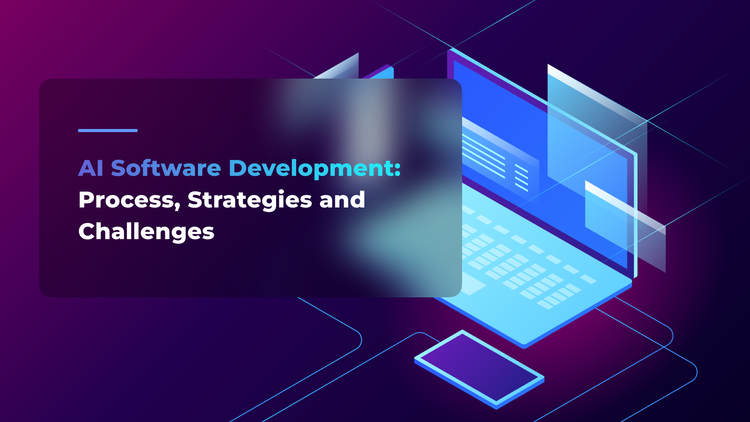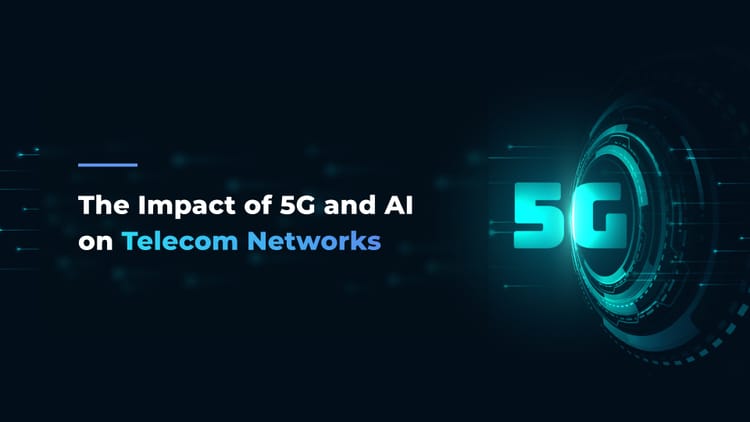What Is MLOps and How to Leverage It for Your Machine Learning Projects
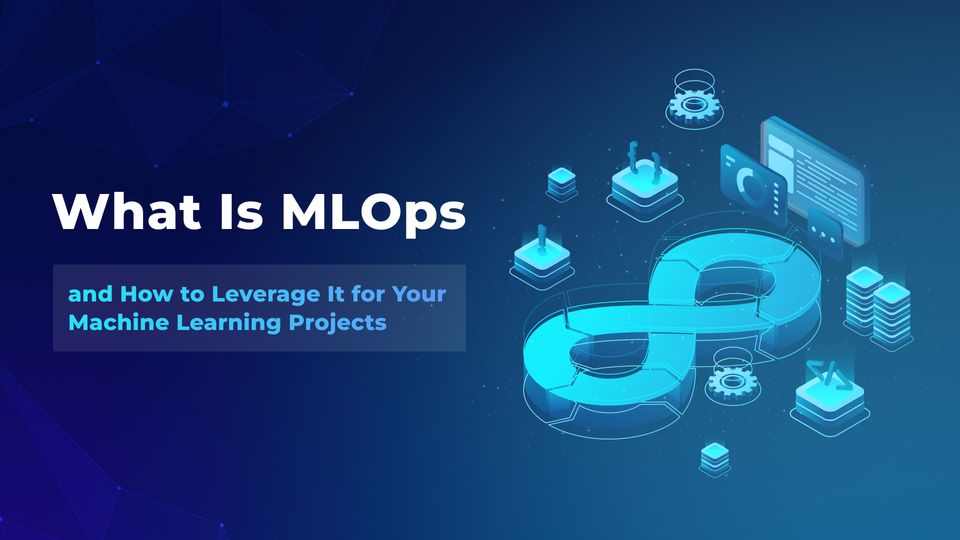
Did you know that 80% of models trained and developed never make it to production? One of the main reasons for this is the lack of collaboration and communication among parties involved in the various stages of an AI-related project. As machine learning products become integral components in various business operations, business owners realize the need for a systematic and automated approach to implementing and supporting machine learning (ML) models. Consequently, they begin to seek solutions. Many DevOps practices come in handy, but ML projects still require an approach tailored specifically to ML. That is why Many businesses are turning to the MLOps process — but what is MLOps, and how can it bridge the gap between machine learning and production? To understand how MLOps fits into the broader picture, it's helpful to first explore the AI tech stack that supports modern AI-driven applications.
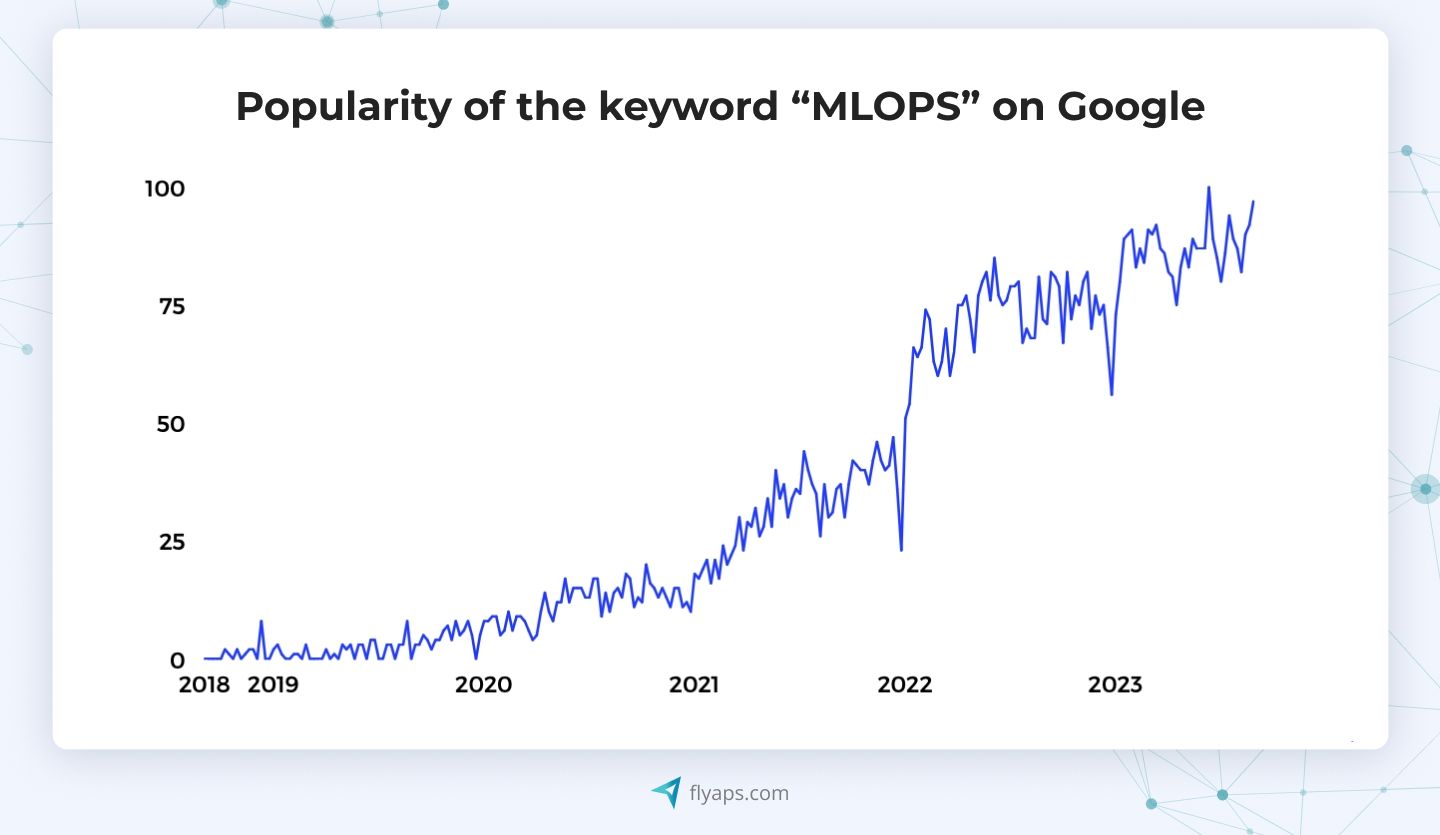
As an AI-focused software development team, we at Flyaps have more than a decade of fish-hand experience with machine learning projects like UrbanSim and CV Compiler. In this article, we will talk about MLOps meaning for businesses and how it will grow models’ chances of reaching production. Moreover, we will cover a few successful MLOps use cases and share some best practices for MLOps implementation. If you're specifically interested in how AI models are applied to generate content, streamline workflows, or drive customer engagement, don't miss our article on Generative AI use cases. But before that, a quick definition.
The machine learning operations (MLOps) definition
Machine learning operations (MLOps) is a methodology designed to automate and streamline workflows and deployments in machine learning projects. MLOps allows to integrate ML application development with system deployment and operations, creating a cohesive approach for managing the machine learning lifecycle.
Imagine a company that specializes in developing machine learning models for personalized recommendation systems. Without MLOps practices in place, their development process is fragmented and time-consuming.
Before adopting MLOps, the company’s data scientists had to manually develop machine learning models, using different tools and libraries per each. This approach led to inconsistencies and duplication of efforts.
Testing was also done irregularly, often leading to missed bugs and errors that were only discovered in production. Integrating a trained and validated model into an existing system required manual intervention, resulting in delays and potential compatibility issues. As the infrastructure for model training and inference was handled separately by the IT team, the outcome was numerous inefficiencies and resource wastage.
After implementing MLOps practices, the data science teams started collaborating using standardized tools and workflows, enabling them to develop and iterate on newly trained models efficiently.
MLOps also allowed to automate three crucial parts of the company’s ML project:
- Testing frameworks to reduce the risk of errors in production.
- Integration of models into production systems to streamline the deployment process.
- Infrastructure provisioning and infrastructure management to optimize resource usage and scalability.
The result? The company now has more streamlined model development and deployment processes and enhanced reliability with automated testing and deployment practices. The ML infrastructure can handle growing data volumes and user demands, which positively contributes to scalability.
MLOps vs DevOps
You can notice some similarities between MLOps and DevOps. But there is a big difference between them, which lies in focus and application.
MLOps is specifically tailored to ML projects and focuses on managing the lifecycle of ML models. DevOps, on the other hand, is a broader approach that primarily focuses on software development and IT operations. It emphasizes collaboration, automation, and integration between software development and IT operations teams to deliver high-quality software efficiently.
MLOps process applies DevOps principles and practices to the unique challenges of machine learning projects. It involves automating and standardizing ML workflows, implementing continuous integration and deployment (CI/CD) pipelines for ML models, and ensuring scalability, reliability, and performance of ML systems in production. DevOps, on the other hand, is applied across the entire software development lifecycle, from code development and testing to deployment and maintenance.
Reasons to implement the MLOps process
The benefits of MLOps are numerous, starting with a more structured approach for overcoming challenges like data management or model deployment to increased value of ML initiatives. Here's a breakdown of the key benefits.
1. Faster time to market
MLOps enables organizations to streamline the development and deployment of ML models, resulting in faster time-to-market for ML-powered solutions. By automating model creation and deployment processes, MLOps reduces operational overhead and accelerates project delivery, allowing companies to respond quickly to changing market demands.
2. Improved productivity
MLOps practices enhance productivity by standardizing development environments, enabling rapid experimentation and facilitating collaboration between data scientists and software engineers. By establishing repeatable processes and workflows, MLOps lets development teams iterate on ML models more efficiently, increasing productivity.
3. Efficient model deployment
MLOps improves the efficiency of model deployment and management in production environments. By integrating model workflows with CI/CD pipelines, organizations can automate the deployment process and ensure consistency across environments. This results in more reliable and scalable deployments with improved troubleshooting capabilities and centralized management of model versions.
4. Cost reduction
By automating repetitive tasks and optimizing resource usage, MLOps helps organizations decrease operational costs associated with ML projects. By standardizing infrastructure provisioning and management, organizations can minimize wastage and improve resource utilization, leading to cost savings in the long run.
5. Enhanced model performance and quality
MLOps practices contribute to improved model performance and quality by enabling active performance monitoring, evaluation, and optimization of ML models in production. By implementing monitoring and governance mechanisms, companies can detect and address issues such as model degradation or concept drift, ensuring that deployed models remain accurate and reliable over time.
The benefits mentioned above vary depending on the industry where ML projects are implemented. Let's delve into the details further in and clarify what we mean exactly.
MLOps across different industries
MLOps across different industries
From healthcare to finance, retail to manufacturing, ML opens up a world of opportunities for companies willing to embrace its potential. Enterprises worldwide and even small startups embrace MLOps to maximize their gains, streamlining operations, enhancing decision-making, and optimizing performance through efficient management of data, algorithms, and infrastructure.
Let's take a closer look at some industries and how they benefit from MLOps implementation:
| Industry | Flow optimization | Modeling and analytics | Predictive insights | Threat and risk management |
| Healthcare | Streamlined patient care processes, optimized hospital operations, and improved resource allocation. | Development of predictive models for disease diagnosis, treatment planning, and patient outcome prediction. | Forecast of disease outbreaks, identification of high-risk patients, and personalization of treatment regimens. | Detection of healthcare fraud, management of regulatory compliance, and mitigation of cybersecurity threats. | Finance | Automated financial transactions, optimized trading processes, and enhanced operational efficiency. | Development of predictive models for credit risk assessment, investment analysis, and market forecasting. | Identification of fraudulent activities, market trends prediction, and optimization of investment strategies. | Detection of fraudulent transactions, financial risk management, and regulatory compliance assurance. | Telecom | Optimized network traffic, improved service delivery, and enhanced customer experience. | Development of predictive models for network performance, customer churn prediction, and capacity planning. | Anticipation of network failures, identification of network congestion, and optimized network infrastructure. | Detection of network intrusions, regulatory compliance management, and network security assurance. | IT | Automated software development pipelines, optimized IT infrastructure, and improved deployment processes. | Development of models for anomaly detection, system failure prediction, and user behavior data analyses. | Anticipation of IT service outages, identification of performance bottlenecks, and optimization of resource allocation. | Cybersecurity threats detection, compliance risks management, and data protection assurance. | Public sector | Streamlined government services, optimized public transportation, and improved resource allocation. | Creation of models for crime prediction and traffic management. | Anticipation of public health crises, identification of social welfare needs, and optimization of urban planning. | Fraud detection in public services, emergency response management, and data privacy assurance. | Oil and gas | Optimized drilling operations, refined processes, and transportation logistics. | Development of predictive models for equipment failure, reservoir characterization, and oil price. | Anticipation of maintenance needs, identification of production bottlenecks, and optimization of exploration strategies. | Safety hazard detection, environmental risk management, and regulatory compliance assurance. | Retail | Optimized inventory management, supply chain logistics, and customer service processes. | Development of recommendation engines, demand forecasting models, and customer segmentation analyses. | Anticipation of consumer trends, identification of purchasing patterns, and personalization marketing campaigns. | Detection of retail fraud, inventory shrinkage management, and data security assurance. |
Now, to better understand what MLOps is in practice, we’ve also prepared some real-life cases for you.
Real-world MLOps use cases
Let's kick things off with our own case and see how MLOps lets our client succeed in the field of urban planning.
UrbanSim: how we prepared the infrastructure for MLOps
Our company was part of the transformation of UrbanSim, a SaaS solution for city development, which is now used in various cities across the U.S., Europe, Asia, and Africa. The platform uses open-source statistical data to predict what happens after particular urban changes to help construction workers and city planners simplify the design and development of urban areas and meet community needs.

Recognizing the limitations of their legacy platform, UrbanSim was looking for a tech team to help them with a complete rebuild. We were a perfect candidate thanks to our experience in reconstructing complex legacy systems, and expertise with modern system architecture. We gathered our top specialists in backend, frontend, DevOps, and ML engineering to undertake the monumental task of rebuilding the platform from scratch, adding new features, and making it ready for ML implementation.
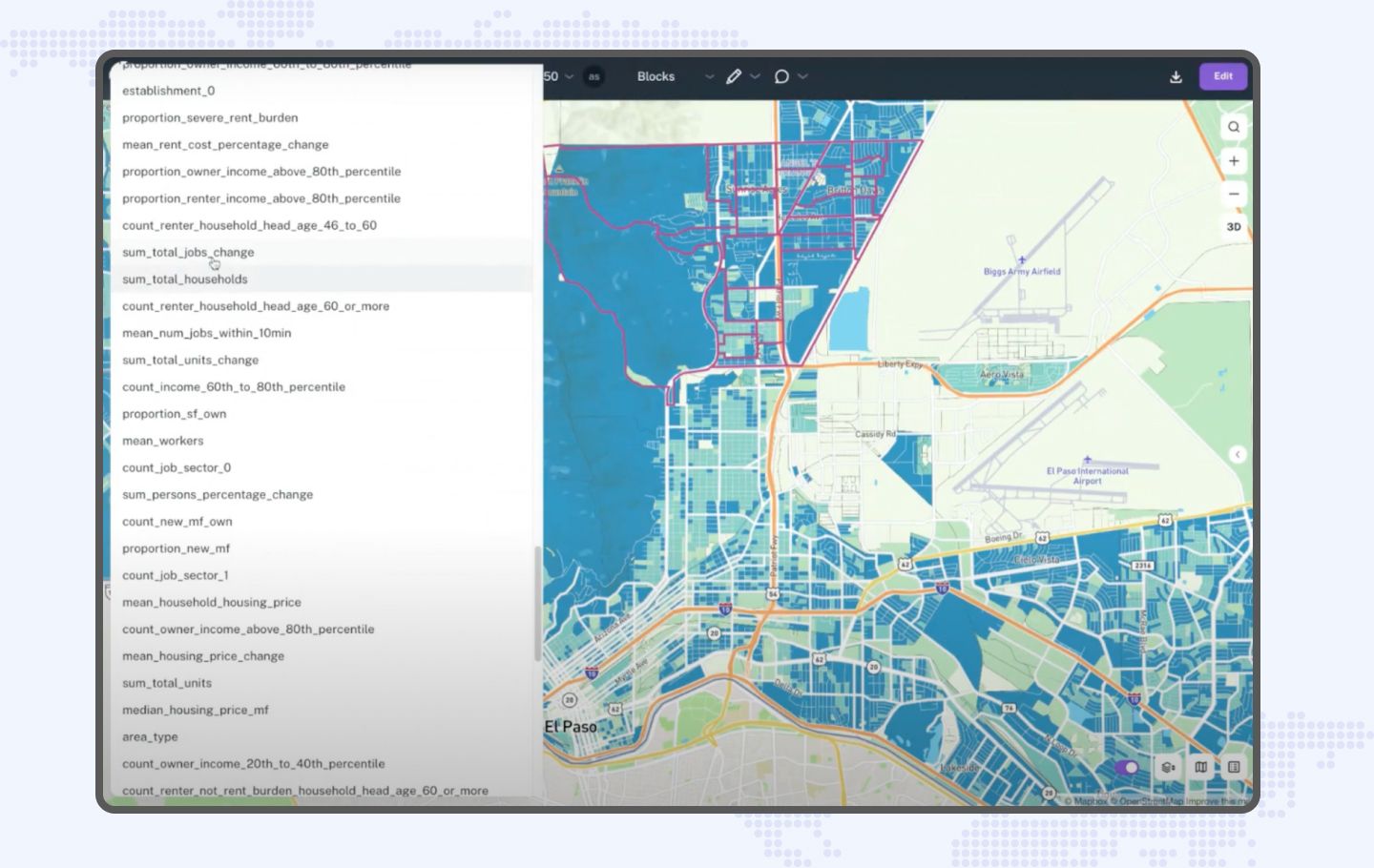
We enhanced UrbanSim's ability to predict urban scenarios using statistical models. Previously trained on historical data, it took a lot of time for the platform to calculate different scenarios. However, after we optimized the code and integrated the models into the system, we managed to reduce the scenario calculation time from hours to minutes. Now the system has become much faster and more efficient, with users being able to quickly create and visualize the required scenarios.
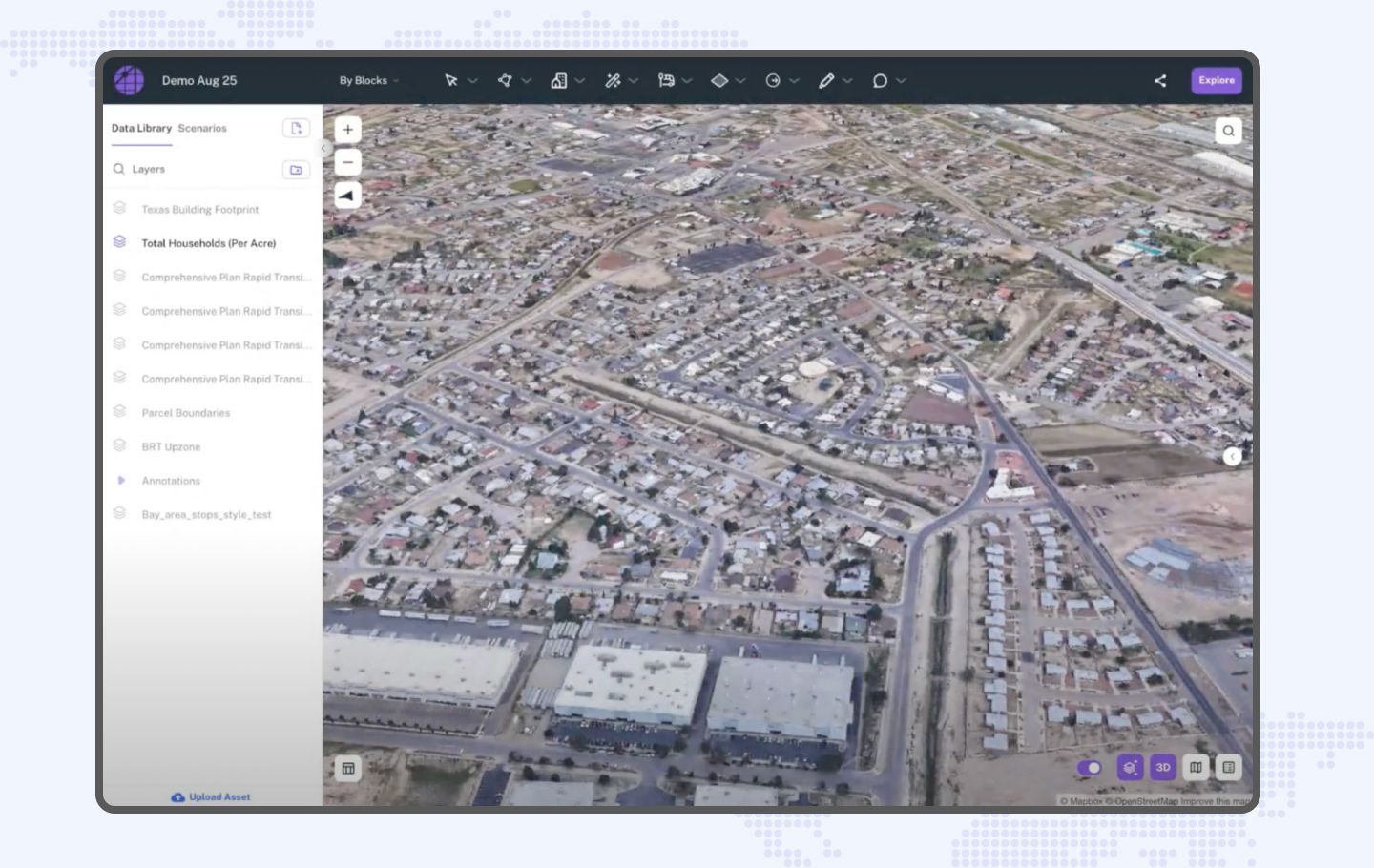
Moreover, we prepared the infrastructure for future machine learning advancements, ensuring UrbanSim is ready to embrace innovations in the field.
After our work was done, UrbanSim received a customizable, scalable, and ML-ready platform that not only meets UrbanSim's immediate needs but also enables future growth and innovation. With a 40% reduction in maintenance costs and the ability to scale and customize for diverse client requirements, UrbanSim is now equipped to embrace the transformative power of AI and ML with confidence and ease.
Ride-sharing: how Uber uses MLOps for a diverse set of applications
Uber, the world's leading ride-sharing company, leverages the MLOps process to drive data-driven decision-making across its diverse services. By implementing ML solutions, Uber optimizes services to estimate driver arrival times, match drivers with riders, and dynamically price trips. However, Uber’s ML solutions extend beyond ride-sharing to their other services like UberEATS, uberPool, and self-driving cars.
Uber manages its ML models through an internal platform called Michelangelo, enabling seamless development, deployment, and operation of ML solutions at scale. Models are deployed to production in three modes: Online Prediction for real-time inference, Offline Prediction for batch predictions, and Embedded Model Deployment for edge inference via mobile applications.
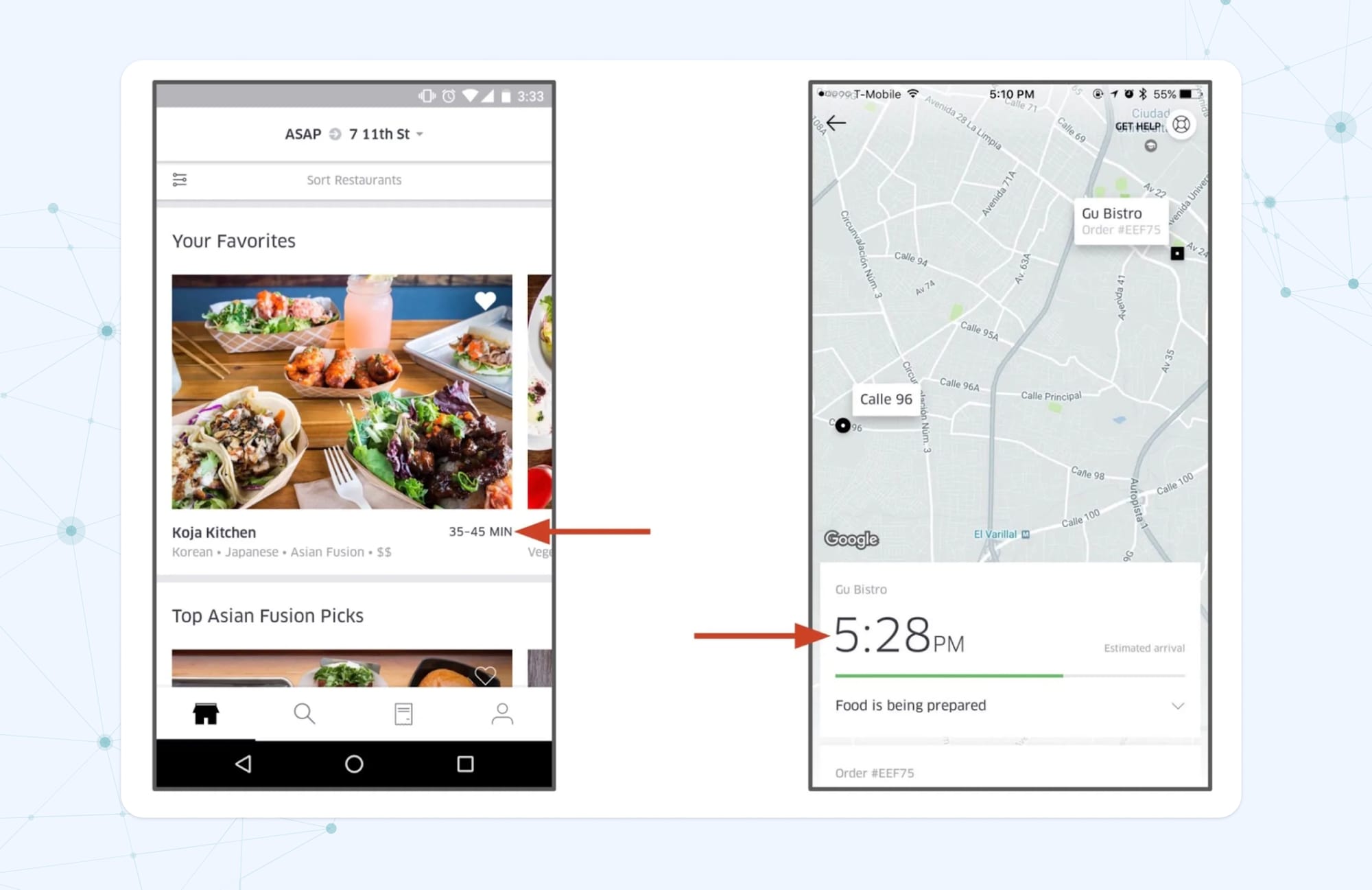
To ensure optimal model performance in production, Uber employs monitoring tools within Michelangelo to track model metrics and detect anomalies. Additionally, Uber applies a workflow system to manage the lifecycle of models in production, integrating performance metrics with alerts and monitoring tools for efficient operations.
Lastly, Michelangelo includes features for model governance, allowing Uber to audit and trace the lineage of models from experimentation to production deployment. This ensures transparency and accountability in model usage and management.
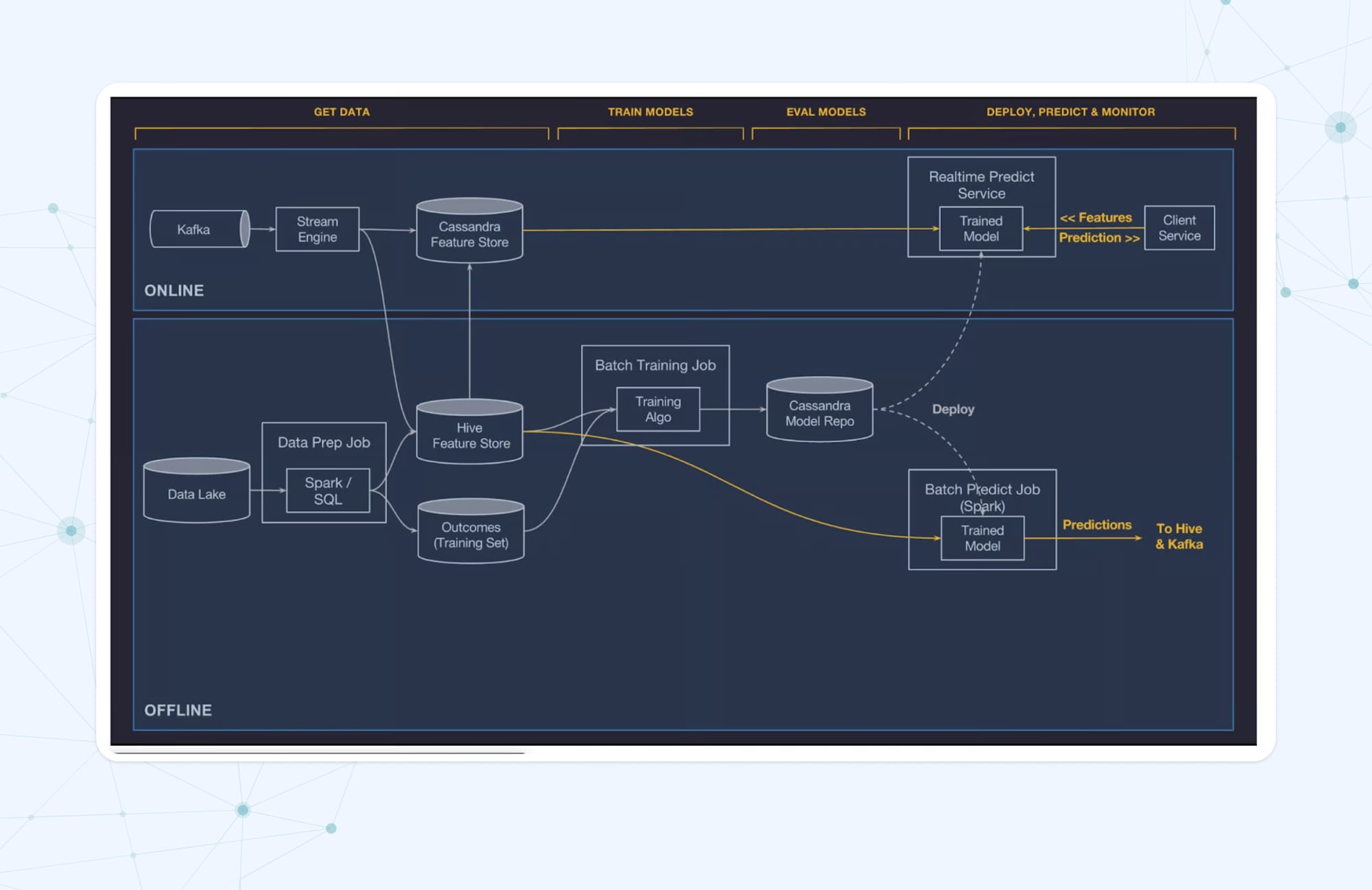
Through its adoption of MLOps, Uber has achieved enhanced decision-making, improved service efficiency, and streamlined model lifecycle management.
Data-processing: how GTS improved its data protection with the MLOps proces
GTS, a leading data processing company based in Germany, has powered up its ecosystem by integrating MLOps into its operations. Specializing in Infrastructure-as-a-Service and Software-as-a-Service platforms - including AI development platforms - for European companies, GTS adopted MLOps to empower its clients with enhanced compute resources, improved reproducibility, and accelerated model deployment.
For their DSready Cloud project, a centralized hub for data science and AI in the cloud, they decided to use the Domino Enterprise MLOps Platform. The platform was a great choice for meeting such GTS’ requirements as enterprise-grade security, customization, self-service infrastructure, more robust collaboration, and governance features.
Overall, Domino helps its users quickly set up computing resources while they create models. It also simplifies the creation, reuse, and sharing of work. Plus, models can be deployed much faster, sometimes within just minutes.
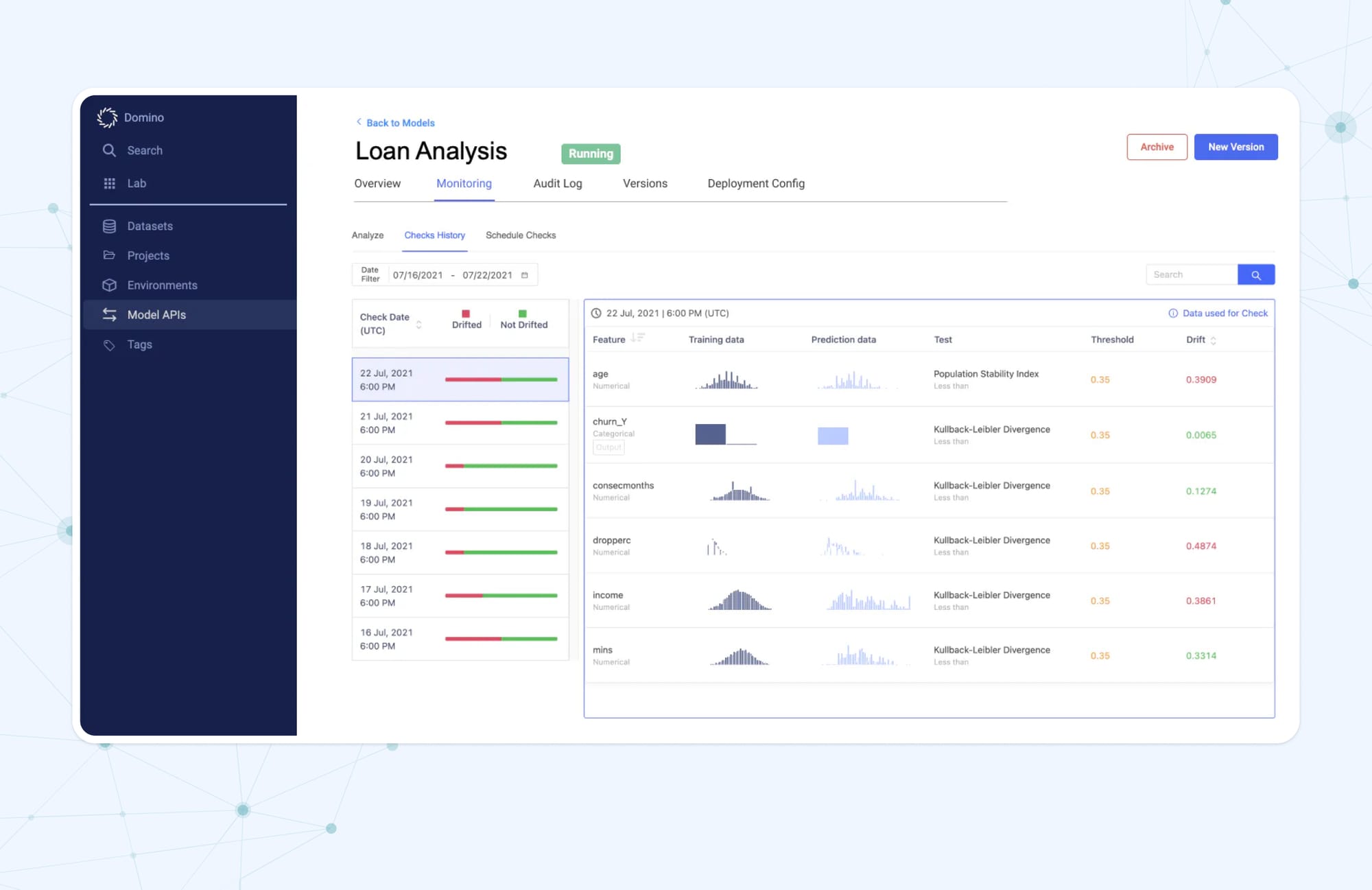
Users of the platform have direct access to all its features. This eliminates the need for any extra software or services outside of Domino’s Enterprise MLOps Platform, thereby enhancing security. Moreover, the platform enables monitoring the performance of a deployed model in production over time.

As enhanced security was the primary goal of DSready Cloud, with Domino, DSready Cloud also gained:
- Control over data. Unlike other cloud options where data might be stored on the provider's servers, Domino lets clients keep ownership while using GTS infrastructure. This ensures data stays secure and follows strict regulations.
- Top-level security. Domino offers strong security features. It has tough authentication services, like Keycloak integration, ensuring only authorized users can access the platform. SSL/TLS connections and mutual TLS add extra layers of security, keeping data traffic safe from unauthorized access.
- High-level encryption. Data in Domino is encrypted when stored and when moving around, using industry-standard methods. GTS even added more layers of encryption, including a 4,000-bit key, to ensure data stays safe.
As a result, GTS has successfully reached their goals of having smoother operations and enhanced security.
6 steps of the MLOps process
As we’ve already mentioned the machine learning lifecycle a few times, let’s dive into this topic a bit deeper and discover what stages exactly you’ll need to go through when implementing machine learning in operations, with some best practices to follow.
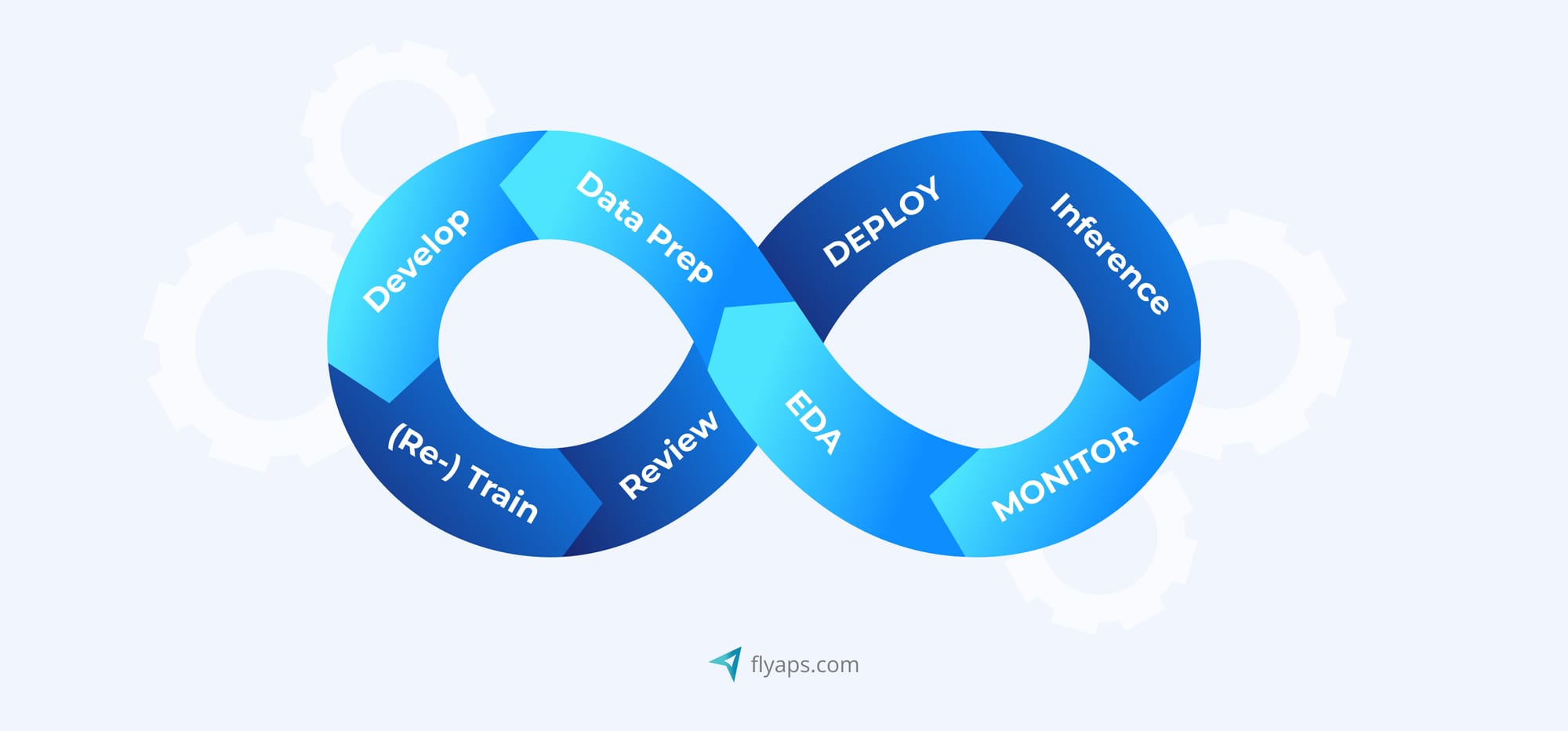
1. Data preparation
Data preparation is critical to the success of your machine learning models. It's about getting your data in shape so your model can learn from it effectively. This includes data collection, as well as cleaning and transforming the data to make it suitable for model training.
Best practices for data preparation
- Ensure data quality
It's important to make sure your data is clean and error-free. Get rid of any errors, odd values, or missing parts. Use techniques such as data validation and quality checks to get the best result.
- Feature engineering
Engage in exploratory data analysis to identify and create the most relevant features for your trained model. Effective feature engineering improves model performance and ensures that the model effectively addresses the problem at hand.
- Data versioning
Just like keeping track of different versions of a document, it's important to keep track of changes to your data. This helps ensure that you can go back to a specific version when needed and maintain consistency. Tools like Git or DVC (Data Version Control) are great for managing and tracking different versions of your data, enhancing collaboration within data science teams.
2. Model training
Once data is all set, it's time to train machine learning models. The model training process is quite similar to teaching a computer to learn from the prepared data. This involves picking the right algorithm or method, giving it the prepared data, and tweaking it to perform its best. You might use techniques like cross-validation, hyperparameter tuning, and ensemble methods to make sure your model is accurate and works well for different situations. The goal here is to create a model that can effectively solve the intended problem.
Best practices for model training
- Experiment tracking
To keep track of all your experiments, including the settings and performance of each one, you can use helpful tools like MLflow or Neptune. This ensures that all aspects of the experiment cycle are documented.
- Hyperparameter tuning
Hyperparameters can be thought of as knobs and dials that can be adjusted to improve your model's performance. To improve your model's performance, try testing different combinations of settings using techniques like grid search, random search, or Bayesian optimization.
- Cross-validation
Cross-validation evaluates how well your model understands the material, ensuring it can generalize to new data effectively. This is crucial for avoiding overfitting and validating the model prediction service.

3. Model evaluation
Model evaluation is the process of determining how well models perform. After training your model, you must test it to assess its effectiveness. This involves examining various metrics, such as accuracy, precision, recall, or area under the curve (AUC), depending on your objectives. Additionally, you must evaluate how well your model performs on new, unseen data by testing it on separate validation or test datasets. This evaluation process ensures that only the most reliable and accurate models proceed to the next stage.
Best practices for model evaluation
- Select appropriate evaluation metrics that align with your specific problem and goals
Common metrics include accuracy, precision, recall, F1 score, or AUC. These metrics aid in comprehending the performance of your model across various aspects.
- Employ multiple evaluation strategies to ensure consistent performance
- Evaluate your model on separate validation and test datasets to avoid bias and overfitting, where the model is too tailored to the training data

4. Deployment
Deployment is the stage where trained models are put into use in the real world. Here, you can make your models available for live environments to make predictions or provide insights. It's important to consider factors such as the number of users your model will have, its response time, and the resources it will require to perform well. There are various ways to deploy models, including batch data processing or real-time interfaces.
Best practices for deployment
- Containerization
Considered containerization as a way to package your model and its dependencies for consistent deployment across various environments, and tools like Docker can help with this process.
- Automated deployment
Imagine setting up a conveyor belt that automatically transports your model from development to deployment. Tools like Kubernetes or serverless platforms can help you create automated deployment pipelines, making the process smoother while reducing the likelihood of errors.
- Version control
It's also important to monitor modifications to your model and deployment setup. You can use version control systems like Git to keep a record of all aspects, including your model versions and deployment configurations.

5. Monitoring and maintenance
Once your models are up and running, it's crucial to keep an eye on them to ensure they're performing well, reliable, and meet business goals. Monitoring means keeping track of different measures like accuracy, response times, and any changes in data patterns. This helps catch any problems early on. You can also set up alerts to notify you if models work improperly. Regular maintenance is key too – this includes things like updating your models with fresh data and fine-tuning them to keep them working their best.
Best practices for monitoring and maintenance
- Set up monitoring infrastructure
Use tools like Prometheus and ELK stack, or create custom scripts to track how your models are doing, spot any changes in data patterns, and see how resources are being used.
- Establish alerting mechanisms
Define thresholds for what's considered normal performance and set up alerts to notify you if anything goes wrong. This could be through email, Slack, or SMS.
- Scheduled retraining
Decide how often your models need updating based on how quickly your data changes and how well your models are performing. Regularly updating your models with fresh data helps them stay accurate and relevant.

6. Retiring and replacing models
Models may become outdated or less effective over time due to changes in data patterns, business requirements, or technology advancements. The retiring and replacing mean assessing the need to retire existing models and introducing newer, more improved models. It requires careful planning and execution to ensure a seamless transition from the old model to the new one while minimizing disruptions in production environments.
Best practices for retiring and replacing models
- Incremental deployment
Plan for a gradual transition by deploying and testing new models alongside existing ones before fully replacing them. This helps minimize disruptions and ensures a seamless transition.
- Document and communicate
Document the reasons for retiring or replacing models and communicate these changes to stakeholders. Provide clear instructions on the transition process and any updates needed for downstream systems.
How Flyaps can help you with MLOps implementation to streamline your machine learning models
With over a decade of experience in software development, we have successfully created numerous solutions, including ML-driven ones. The solutions we created are used by over 100 companies worldwide with business giants like Orange Group and Hutchison 3G UK Ltd in this list. So when it comes to empowering ML development with beneficial practices like MLOps, there are at least three reasons why we can be a valuable partner.
Customized MLOps solutions
As an AI-focused software development team, we at Flyaps can create tailored MLOps solutions specific to your business needs and infrastructure. This could involve developing custom pipelines for data preprocessing, model training, deployment, monitoring, and maintenance, ensuring seamless integration with existing systems and workflows.
Automated model deployment
Implementing automated deployment pipelines for machine learning models can significantly streamline the deployment process. We can develop automated deployment scripts or use containerization technologies like Docker and Kubernetes to package and deploy models consistently across different environments.
Model versioning and management
Managing multiple versions of machine learning models is crucial for reproducibility and tracking changes over time. Our team can develop version control systems tailored to machine learning models, enabling efficient tracking, management, and collaboration on model development and deployment.
Still not sure if the MLOps process is the best decision for your ML project? Drop us a line to discuss and find the best solution together.


